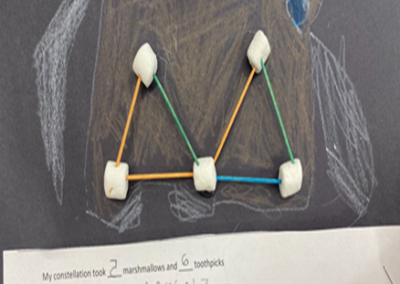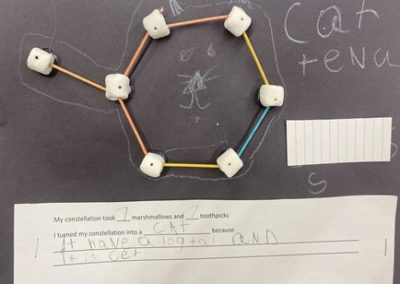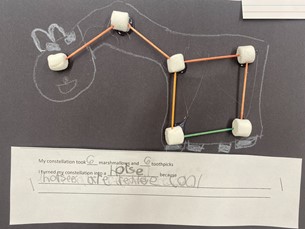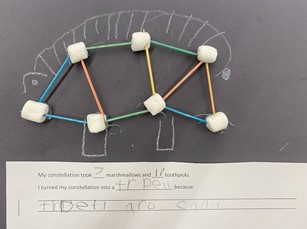Constellation Creation
Developed by Katherine Smith, PCM Play Intensive 2021
(FOCUS: K-2, Science, Literacy, Math, STEM)
This lesson is part of a big Space unit in Kindergarten. Students connect to stars all the time, whether it be stargazing at night with their family or wondering about why stars are so bright. This is a great lesson to help deepen their understanding about the extraordinary world of stars and the importance that constellations played in history. This lesson incorporates science, art, literacy and math in an engaging hands-on activity.
After learning about Stars and constellations through different read alouds the students will be given the chance to create their own constellation using small marshmallows and toothpicks. After the students are done designing their constellations, they will then be provided with a challenge to see if they can turn their constellation creation into an animal of their choice using white crayon.
Materials
- Small marshmallows
- Toothpicks
- Black paper
- Liquid Glue
- Writing page
- Pencils
- White crayon
- White playdough
- (Optional): Books on Stars or Constellations
Set Up
The students will be provided with a piece of black paper, a handful of tiny marshmallows and toothpicks. There will be extra materials on the back tables so that students can come up if they run out. The children will be creating their constellations at their seats. The glue will be handed out after their engineering step has been checked by a teacher. Once the teacher gives the green light the students can glue their constellations onto their black paper.
Suggestion: As students start to finish, call them up one by one and hot glue gun their creation to the black paper. This will help secure them more.
Student’s Job
Challenge: Turn your marshmallow constellation into an animal of your choice by using white crayon.
- Listen to the stories and videos about constellations and learn why they were important in our history.
- Practice making some of the famous constellations that you learned about using white playdough.
- Create a constellation using marshmallows and toothpicks.
- After getting your constellation checked by the teacher, glue your constellation onto black paper or have your teacher hot glue gun it.
- After you are done making your constellation it is time to put on your creative glasses and imagine an animal that you can turn your constellation into.
- Use white crayon to outline your constellation into an animal of your choice.
- On the bottom of your paper write about how many toothpicks and marshmallows you used and what animal you turned your constellation into.
Further Challenges:
If students are having trouble getting started, you can provide pictures of example constellations. The students can also use geoboards and elastics to brainstorm their constellation building ideas. Send home an at-home project over the time span of a week to see if your students and families and can spot constellations in the night sky.
Teacher’s Job
Standards Alignment
COMMON CORE STATE STANDARDS.MATH.CONTENT.K.COUNTING & CARDINALITY.A.3
Write numbers from 0 to 20. Represent a number of objects with a written numeral 0-20 (with 0 representing a count of no objects).
COMMON CORE STATE STANDARDS.MATH.CONTENT.K.COUNTING & CARDINALITY.B.4
Understand the relationship between numbers and quantities; connect counting to cardinality.
NEXT GENERATION SCIENCE STANDARDS: EARTH’S PLACE IN THE UNIVERSE
1-ESS1-1: Use observations of the sun, moon, and stars to describe patterns that can be predicted.
Prepare/ Background Info
This lesson is a part of our Space kindergarten unit. Each day the students learn about a different planet while working on hands-on activities and crafts. At the end of this unit the parents come in to celebrate all of the students’ hard work during our “Space Fair”
Facilitation Strategies
- Help students feel confident in building their constellations by showing examples through printed out pictures or on the smart board. Explain the background of constellations and how they helped people find their way when traveling.
- Provide clear instructions on what is to be expected of the students during the engineering process.
- Quiet voices
- Responsible behavior with the materials
- No eating the marshmallows
- Provide students with plenty of time to design and create their constellations. After they are done make sure to check it before they glue it on the black paper.
- After the students are done creating their constellation, discuss with students that some of the most famous constellations are named after animals. Challenge the students to turn their constellation creation into an animal of their choice.
- If students are having trouble visualizing what animal to turn their constellation into, have them look at some animal books or brainstorm with a partner.
- On the black paper they can write their constellation name, how many toothpicks they used and how many marshmallows.
- Collect their work when they are complete and instruct the students to take out a book to wait patiently for the rest of the class to finish.
- (Part 2): This can be completed the same day or a different day.
- Have the students write what animal they turned their constellation into and why.
Play to Notice
- Choice: The students can choose which animal they want to turn their constellation into. This helps the students use their imagination and creative thoughts.
- Active: Students will be very active in brainstorming and creating their creations.
- Emotional/Social: Students might have strong feelings during this lesson. They might be overly excited or maybe overwhelmed/discouraged if their constellation does not turn out the way they would like. It is important to go over good coping strategies if these feelings arise.
Content Matter to Notice
- Math: Notice students who are having trouble using 1:1 correspondence when counting and writing their numbers
- Literacy: Notice the students’ phonics and writing skills.
- Science: Take notice of the student’s understanding of constellations.
SEL to Notice
Notice students who have those “lightbulb moments” and try to use them as “helpers” for students who are having a harder time getting started.






0 Comments